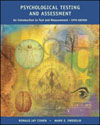Psychological Testing and Assessment: An Introduction To Tests and Measurement, 5/e
| Actuarial prediction | In clinical practice, the application of empirically demonstrated statistical rules and probabilities as a determining factor in clinical judgment and actions; contrast with clinical prediction and mechanical prediction, 560-561
|
 |
 |
 |
| Behavioral assessment | An approach to evaluation based on the analysis of samples of behavior, including the antecedents and consequences of the behavior, 388-403
|
 |
 |
 |
| Central processing | Computerized scoring, interpretation, or other conversion of raw test data, physically transported from the same or other test sites; contrast with teleprocessing and local processing, 555-556
|
 |
 |
 |
| Computerized adaptive testing (CAT) | An interactive, computer-administered testtaking process wherein items presented to the testtaker are based in part on the testtaker's performance on previous items, 546
|
 |
 |
 |
| Consultative report | A type of interpretive report designed to provide expert and detailed analysis of test data that almost mimics the work of an expert consultant, 558.
|
 |
 |
 |
| Descriptive report | A type of inter-pretive report that features brief, scale-by-scale narrative summaries, 558.
|
 |
 |
 |
| Extended scoring report | A type of scoring report that provides not only a listing of scores but statistical data as well, 558.
|
 |
 |
 |
| Integrative report | A form of inter-pretive report of psychological assessment, usually computer-generated, in which data from behavioral, medical, administrative, and/or other sources are integrated; contrast with scoring report and interpretive report, 558
|
 |
 |
 |
| Interpretive report | A formal or official computer-generated account of test performance, presented in both numeric and narrative form and including an explanation of the findings; the three varieties of interpretive report are descriptive, screening, and consultative; contrast with scoring report and integrative report, 558
|
 |
 |
 |
| Item bank | A collection of questions to be used in the construction of tests, 547, 549-552
|
 |
 |
 |
| Item branching | In computerized adaptive testing, the individualized presentation of test items drawn from an item bank based on the testtaker's previous responses, 547, 552-553
|
 |
 |
 |
| Local processing | On-site, computerized scoring, interpretation, or other conversion of raw test data; contrast with central processing and teleprocessing, 556-557
|
 |
 |
 |
| Mechanical prediction | In clinical practice and other fields, the ap-plication of statistical rules and probabilities, as well as computer algorithms, in the computer generation of findings and recommendations; contrast with clinical prediction and actuarial prediction, 561
|
 |
 |
 |
| Screening report | A type of interpretive report that provides information on each of the scales as well as the relationship between some of the scales, 558.
|
 |
 |
 |
| Simple scoring report | A type of scoring report that provides only a listing of scores, 558.
|
 |
 |
 |
| Teleprocessing | Computerized scoring, interpretation, or other conversion of raw test data sent over telephone lines by modem from a test site to a central location for computer processing; contrast with central processing and local processing, 556
|
 |
 |
 |
| Validity | A general term referring to a judgment regarding how well a test or other measurement tool measures what it purports to measure; this judgment has important implications regarding the appropriateness of inferences made and actions taken on the basis of measurements, 29-30, 32-33, 154-186
|



 2002 McGraw-Hill Higher Education
2002 McGraw-Hill Higher Education